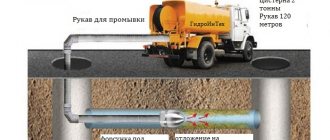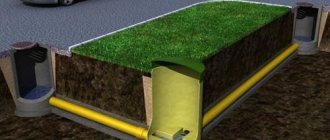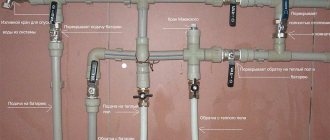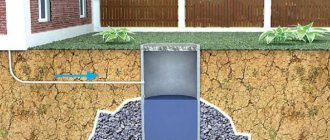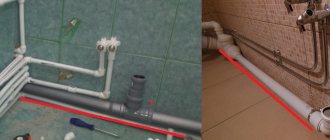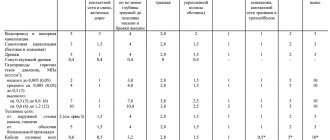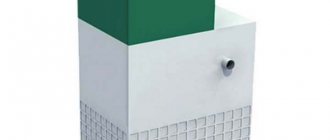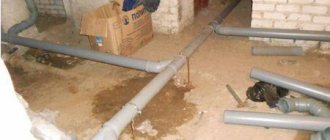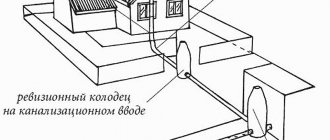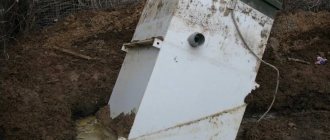Why is SES permission required for installing a septic tank?
The construction of a sewer system on any suburban area is a complex of complex works that involves not only laying pipes, but also installing a cesspool or a finished septic tank. To install a septic tank, permission from the SES is required. There is no way to do this without collecting a package of documents. Why is this required? The problem is that groundwater and the soil itself can be contaminated by runoff and chemical waste. Improper cleaning of a septic tank with chemicals can lead to various diseases and contamination of the residential area of the entire site. Therefore, before starting work, it is necessary to design a sewer system, collect a package of documents and submit an application to the SES.
Before constructing a sewer system, you need to make a project, then collect the necessary documents and submit an application to the SES.
Documentation package
A septic tank is an installation for the accumulation and treatment of household waste. Not only liquid but also solid waste, harmful gases, and microorganisms accumulate in sewer tanks. Such installations require constant monitoring by sanitary and epidemiological authorities. This makes it possible to protect groundwater from contamination, prevent the spread of various diseases, and prevent wastewater from entering the residential area. For the safety of both yourself and others, you must obtain appropriate permission to use a septic tank.
How to obtain permission from the SES and where, what package of documentation will need to be collected? Among the main documents that will be required by the SES, it is worth noting:
- availability of a technical passport;
- a detailed diagram of the septic tank installation, which the design organization will help you draw up;
- project for a residential building;
- package of documentation on ownership of the site and building;
- detailed topological survey of the entire site (obtained from the relevant organization);
- an agreement with various organizations on the removal of all liquid household waste.
Scheme of a multi-chamber septic tank.
After the documentation package has been collected, you can submit an application to the SES for the installation of a septic tank. This is done either by the sanitary epidemiological station of the region or by an environmental protection organization. It must be remembered that the application can only be submitted together with a package of documentation. You will have to wait about a month for permission from the SES. There is one more point in installing septic tanks for suburban areas. After installing a wastewater storage tank, SES has the right to conduct scheduled and unscheduled inspections. Employees have the right to check the quality of wastewater treatment and the contents of the septic tank.
When do you need to obtain permission to install a septic tank?
In principle, according to the law, if the sewerage system is not connected to the central system, there is no need to coordinate its installation with anyone. However, this does not mean that you are free to install a septic tank however and wherever you want, even on your own property.
There are special norms and rules for the installation of autonomous sewers, which can be found in SNiP. If these rules are violated (especially in a sanitary or water protection zone), this will lead to complaints from neighbors, inspections, fines, and, if all conditions are not met, to the dismantling of the septic tank.
When you turn to specialists, the laying of pipes, installation of autonomous sewerage and filter wells - everything will be done by them. Accordingly, the company itself undertakes to test groundwater for quality, and also provides you with all the necessary documentation.
If the site is located outside the sanitary zone, no permits are needed. It is enough to follow all SNiP requirements during installation. You should always have the certificate and documents for the septic tank, just in case.
The installation of a biological treatment station with UV technology for wastewater disinfection in the water protection zone will have to be approved. Otherwise, the SES will fine you
By the way, if you are going to install a septic tank not at the dacha, but on the territory of a permanent residence, it is still better to go and get permission.
As for installing a do-it-yourself septic tank, you need to coordinate not only the installation of the septic tank, but also the project for the future autonomous sewer system. We will describe in more detail the process of obtaining permission to install a homemade septic tank below, at the very end of the article.
Location conditions
You can’t just install a septic tank or cesspool on your property, since any sewer system poses a certain danger. If permission for installation has been received from the SES, you can begin installing an external sewage system. There are certain standards that regulate the distance from various objects, the depth of holes and other conditions.
To obtain permission from epidemiological stations to place a septic tank, you will have to choose the right location for the tank.
Today, SNiP 30-02-97 and SanPiN 42-128-4690-88 have a whole list of requirements for the location of cesspools on the territory of a personal plot:
Diagram of a septic tank for a cesspool.
- storage pits must be located on the territory adjacent to a private house; it is not allowed to discharge wastewater beyond the boundaries of the site without the appropriate connection and permission;
- the cesspool for drainage should be located at a distance of 10 m from the water main and 20 m from the drinking well, so that clean drinking water does not become contaminated with household waste, chemicals and wastewater;
- the distance from the septic tank to a residential building and other structures should be approximately 10-12 m. A closer location can lead to flooding of the foundation in the spring and destruction of building structures;
- there should be a distance of 1 m from the septic tank to the fence;
- The depth of the cesspool should not be more than 3 m, otherwise its maintenance will be difficult. A thick layer of silt and solid sediment will constantly accumulate at the bottom.
Types of septic tanks for a country house
Previously, when the production of plastic septic tanks was not so widespread, reinforced concrete structures, which were installed in stages, were more popular. Metal cleaning systems were also used. Today, wastewater treatment most often occurs using ready-made plastic plants. These products are reliable and durable. A high level of sealing ensures environmental safety of the installations. Depending on their performance characteristics, they are classified according to different criteria.
- The classic storage option is an analogue of a conventional settling pit into which wastewater flows.
Water is stored in such tanks until it is pumped out by a sewer truck. Storage units require regular cleaning. Although the cost of such containers is small, frequently calling machines for cleaning is not a cheap “pleasure.” Therefore, such a choice can hardly be called economical.
- With soil treatment - this option defends and purifies wastewater through a special drainage field.
The water is thrown out, and sediment remains in the container itself, which must be removed 2-3 times a year using special equipment. As a result of treatment in such a septic tank, the water becomes 60-85% cleaner. Energy independence and ease of operation are the advantages of such a structure. But it cannot be installed in areas with high aquifers due to poor purification through soil filters.
- A septic tank with deep biological treatment - in this case, you can achieve a high level of wastewater treatment (98-99%) and even reuse the liquid for household needs or for watering the garden.
This option uses all types of wastewater treatment: chemical, biological, mechanical. Such tanks can be installed in any type of soil, they do not rot and can last for several decades. The disadvantages of biological septic tanks include their energy dependence. Therefore, in areas where there are frequent power outages, it will be difficult to achieve normal operation of the installation.
- The classic storage option is an analogue of a conventional settling pit into which wastewater flows.
- Made of reinforced concrete - this option can be chosen for houses where people live out of season, that is, all year round. They last a long time, but require good waterproofing and are quite difficult to install.
- Plastic containers can be installed in areas where the groundwater level is high. Plastic septic tanks for private homes are not subject to corrosion and are not afraid of the influence of aggressive environments.
- Metal tanks are made of stainless steel. However, compared to their plastic and concrete counterparts, they are not as durable and practical. In addition, such septic tanks are quite expensive.
- A horizontal septic tank is most often chosen for areas where water from the ground rises high in the autumn-spring period.
The horizontal container has the shape of a cylinder and is made of plastic or stainless steel. Suitable for installing a country house with a large amount of waste water (10 or more cubic meters).
- A vertical type septic tank is buried deeper than a horizontal tank.
Such products are suitable for installation in sewer systems with a small volume of wastewater (up to 2 cubic meters). However, such a tank is more airtight than the horizontal version.
- Sometimes a combined version of horizontal and vertical septic tanks is used, where each container is responsible for certain wastewater from the bathroom, kitchen or toilet.
- A horizontal septic tank is most often chosen for areas where water from the ground rises high in the autumn-spring period.
By location
- Underground is a more common version of the structure, which is buried to a certain depth. At the same time, the landscape of the site does not suffer.
- The above-ground version of the structure is used if the geology of the site does not allow the installation of an underground option due to the high groundwater level. In this case, the septic tank will spoil the landscape of the site, so it should be mounted away from the viewing angle.
Device options
Today it is possible to install various designs of cesspools for storing and partially processing wastewater. It can be:
- ordinary cesspools;
- engineering systems for accumulation and partial processing and separation of wastewater mass.
Sump pit diagram.
The simplest option, which is provided by the relevant permitting services, is cesspools that do not have an equipped bottom. They are constructed if the daily volume of wastewater discharged from a residential building is no more than 1 m³. Sewage pits are installed below the drinking water level so that the water in the well is not contaminated by wastewater.
When installing a septic tank, various parameters must be taken into account:
- requirements for the location of the pit;
- taking into account the type and properties of the soil at the installation site.
Standards for the location of a septic tank and a well in one area:
- if the site has clay soil, the distance between the well and the septic tank should be 20 m;
- for loam - from 30 m;
- for sandy loam and sandy soil - from 50 m.
If the planned volume of waste per day is more than 1 m³, you will have to abandon the design without a bottom in favor of a concrete or brick pit, a PVC or metal septic tank.
Septic tank material.
Polymer septic tank
All modern septic tanks are made of polymers or metals. Among the features of polymer products it is worth highlighting:
- The simplest types of polymer septic tanks have the most reasonable price. In most cases, they are also equipped with special ribs that prevent them from “floating up”. Nowadays, there are several types of polymer devices:
- Septic tanks made of polyethylene have the lowest cost and have excellent tightness. Their main drawback is their reduced resistance to hot water.
- Septic tanks made of polypropylene are more durable and more resistant to aggressive environments and temperature fluctuations.
- Fiberglass septic tanks are the best polymer option, despite their higher cost. They have increased resistance to aggressive environments (including chemically active substances). They can be used to process industrial wastewater.
The service life of polymer products is more than 50 years.
Metal septic tanks have the following features:
- sensitivity to temperature fluctuations. When using the product in the cold season, it is necessary to properly insulate it.
- The metal for the device must undergo high-quality treatment with waterproofing substances.
Expert advice
For the external sewer system of a private house, sealed septic tanks are recommended, which are not only more convenient to use, but are also highly reliable. They are usually installed by specialized stations. SanPiNs for them are as follows:
Sewerage diagram for a country house.
- During installation, the bottom of the pit should be inclined towards the service hatch, which is necessary for subsequent maintenance;
- the installation location is selected in such a way that the septic tank is located about 10 m from the residential building, and 1 m from the fence of the site;
- a sealed cesspool requires periodic cleaning with a special sewage disposal machine.
It is worth paying attention to a number of tips given by experts:
- for the access of special equipment it is necessary to provide a spacious and convenient place, so there is no need to hide the septic tank in the far corner of the site;
- During operation of the tank, methane may form, so it is recommended to equip the tank with a special ventilation system. According to the requirements of the sanitary and epidemiological station, it will be necessary to provide a ventilation pipe with a diameter of 10 cm. The height of the pipe above ground level should be 60 cm.
Communications supply
Scheme of the location of the cesspool relative to other objects.
A sanitary permit will have to be obtained not only for the installation of septic tanks, but also for all utilities that are located nearby. There are certain standards for the placement of pipes on the site:
- reinforced concrete and asbestos-cement pipes must be located at a distance of 5 m or more from the septic tank;
- cast iron pipelines with a diameter of up to 200 mm must be located at a distance of 1.5 m from the wastewater sump;
- cast iron pipelines with a diameter of 200 mm or more can be located at a distance of at least 3 m from the septic tank;
- gas pipes can be located at a distance of 5 m from the location of the septic tanks.
When installing a septic tank on a personal plot, you must remember to comply with all sanitary standards and obtain the appropriate permit. Sanitary standards regulate the location of the septic tank and establish minimum distances for laying other communications on the site. Taking into account the SES and installation of the septic tank relative to the location of the residential building and other buildings. It is worth being prepared for periodic inspections by employees of the sanitary and epidemiological station. But you should not be categorical about this, since all this is done for the safety of you and others.
Independent sewerage for apartment buildings.
One of the main tasks facing developers constructing high-rise residential buildings is connecting all utilities, ensuring the supply of electricity, hot and cold water, heating, and connecting other systems to the house, allowing potential residents to enjoy all the benefits of civilization.
In addition, sewerage problems in new apartment buildings in the Moscow region should be resolved as efficiently as possible. It’s good if their construction is carried out in an area with already developed infrastructure - then you can simply connect the residential complex to a centralized network. But what if it is completely absent or simply cannot cope with a significantly increasing load?
Features of a septic tank for a summer residence
There are a large number of companies on the domestic market specializing in the production of local cleaning equipment intended for dachas. There are many offers on the market and to make the right choice you will need certain knowledge.
Among the general assortment of septic tanks suitable for temporary housing, there are not so many. So, the optimal solution would be to purchase an inexpensive device that does not require special or complex care. And such equipment includes anaerobic plastic multi-chamber products.
The principle of operation of any septic tank of the specified type, operating without pumping, is that contaminated water passes through several containers connected to each other.
Moreover, in each of them waste is processed using anaerobic bacteria - organisms that do not require air.
Since suburban construction is booming and people love to live in comfort, the wastewater treatment industry is booming. Therefore, we have a fairly large number of manufacturers working in this market segment. But not every one of them produces equipment for dachas. Therefore, the choice of manufacturer must begin with determining what kind of septic tank is needed
Such a process cannot be compared in activity, speed and efficiency with biological stations. Nevertheless, it is able to cope with 80-85% of contaminants. And all this without human intervention and without consuming electricity.
In addition, such equipment costs several times less than modern aeration plants.
Requirements for autonomous sewerage for apartment buildings
The only way out of this situation is an autonomous sewer system for apartment buildings. But the options with cesspools and other similar structures are absolutely not suitable in this case, since the construction company will have to undertake not only their implementation, but also very expensive maintenance, removal and disposal of wastewater using special equipment, the rental of which is expensive .
There remains the option of purchasing and installing a modern septic tank, but even in this case, a number of nuances must be taken into account. For example, sewerage for apartment buildings must meet the following requirements:
- processing of large volumes of water, as well as resistance to large volley discharges or uneven flow of wastewater into the system;
- high quality cleaning. Very often it is necessary to discharge purified water into reservoirs located near residential complexes, so all measures should be taken to minimize environmental pollution;
- simple maintenance. It can be carried out both by construction organizations installing sewerage systems in apartment buildings, and by utility services or service companies. Payment for this service is included in the rent, so a minimal amount of work will help keep it to a minimum.
All these requirements are fully met by the autonomous sewage system of apartment buildings Unilos MEGA, the purchase of which we offer to construction companies. It has a simple modular design and can be installed in separate units with subsequent expansion of the system. This station differs from analogues offered on the modern market by its increased operating efficiency, as it can effectively perform the following functions:
- mechanical wastewater treatment, filtration of contaminants that do not dissolve in water;
- high-quality biological treatment using activated sludge, which destroys organic matter and nitrogen compounds;
- post-treatment of wastewater in a special unit located in a separate room;
- disinfection of clarified water before its discharge into a reservoir.
As a result, the wastewater is purified to such an extent that it can even be discharged into drinking water bodies. In addition, the advantages of the independent sewage system Unilos MEGA include:
- ease of installation, the ability to carry out all work on sewerage installation in apartment buildings independently or with the involvement of specialists from our company;
- economical energy consumption;
- a large selection of MEGA septic tanks, designed to work with different numbers of consumers and different volumes of wastewater;
- the possibility of long-term use of private sewerage for an apartment building with minimal maintenance.
All this will allow the developer of a modern residential complex to install and put into operation an effective sewer network within a few weeks, which will successfully cope with the treatment of large volumes of wastewater.
The principle of operation of a septic tank without pumping
Systems of this type operate without odor and unnecessary noise - even if you are nearby, you will not hear or feel anything. Moreover, the treatment system often includes not only mechanical treatment (requiring electricity), but also biological treatment, which makes it possible to achieve high purity of wastewater - up to 98% required by modern standards.
The work proceeds according to the following scheme:
- First, wastewater from the house gets inside and undergoes primary treatment, which includes mixing the wastewater together with activated sludge (which creates the necessary conditions for the life of bacteria);
- The prepared wastewater moves to the next chamber, undergoing filtration (large and insoluble particles, as well as fat, are eliminated). Here bacteria begin to process, all contaminants precipitate;
- Clarified water undergoes the last stage of filtration and is discharged outside the housing.
This is very practical, because the fallen sludge is stabilized and returned to the first chamber, where it is reused. As a result, sewage pumping is not required (only scheduled, which is carried out once every 10 years or a little more often, depending on how many people live in the house).
How to maintain Unilos MEGA
As we have already mentioned, maintenance of autonomous sewerage systems in apartment buildings can be performed by a service company or a housing office. You can also contact us - experienced specialists will always come to the rescue, ensure timely and high-quality work on eliminating excess activated sludge, which gradually accumulates during the operation of the station, diagnosing compressor and pumping equipment, repairing or replacing airlift elements.
Professional maintenance of a sewerage cleaning system for an apartment building makes it possible not only to ensure its flawless operation, but also to avoid unpleasant emergency situations due to a decrease in equipment capacity, pump or compressor breakdown.
What are the consequences of incorrect placement?
soil freezing table
Since a septic tank is a reservoir where sewage is accumulated and treated, special requirements are placed on it. Before proceeding with installation, you will have to complete the project and approve it with the SES. This will allow you to obtain permission to carry out installation work. However, only if the project fully complies with all standards for installing a septic tank in a given area.
The main issue is the correct site for the equipment. So, where on the site to place a septic tank? This is determined taking into account the current standards prescribed in:
They indicate distances to water intakes, residential buildings and other objects. An important condition is compliance with the standards for installing a septic tank near a well with drinking water
It is very important that waste does not get into the water. Otherwise, it will not only lead to pollution, but also pose a threat to human health
There should be the maximum possible distance between the container and the well. It is determined by the height of the layers between the aquifers and the soil used as a filter for treated wastewater.
If there is no connection between them, then a gap of at least 20 m is allowed. This can be determined using hydrogeological studies. According to experts, light soils are considered the best natural filters. If you have such soil, then the gap between the septic tank at your summer cottage and the well should be more than 50 m.
Services for the installation of autonomous sewerage systems in apartment buildings
In addition to high-quality maintenance of autonomous sewage systems of apartment buildings, our company provides the following services:
- selection of Unilos MEGA wastewater treatment complexes for a specific facility, performance of all necessary calculations and studies, development of projects and schemes for autonomous sewerage of apartment buildings;
- installation of the station, including excavation work, construction of prefabricated buildings for post-treatment and disinfection units, installation and connection of Unilos MEGA and commissioning of equipment;
- if necessary, carry out repair work, replace individual elements of the station, as well as its expansion and installation of new units to improve the quality of wastewater treatment.
Sanitary standards for pits and septic tanks.
The problem of draining domestic wastewater in a private house or on a summer cottage is solved in most cases by installing a cesspool or septic tank. Due to the fact that wastewater can have a significant impact on the environment and the health of the population, primarily the homeowner’s family, all aspects of the creation and placement of these structures are strictly regulated by legislation.
The problem of draining domestic wastewater in a private house or on a summer cottage is solved in most cases by installing a cesspool or septic tank. Due to the fact that wastewater can have a significant impact on the environment and the health of the population, primarily the homeowner’s family, all aspects of the creation and placement of these structures are strictly regulated by legislation.
All activities related to this issue are regulated by the Federal Law “On the Sanitary and Epidemiological Welfare of the Population” N 52-FZ,
which was adopted on March 30, 1999.
This law primarily protects the health of the homeowner. He has a personal interest in complying with the provisions of the law, since if the rules and regulations contained therein are violated, the health of his family members and his own life will be at risk. From a legal point of view, strict compliance with the law is the responsibility of citizens of the Russian Federation, and its violation entails liability provided for by law.
Benefit
It's time to summarize the comparison of a septic tank and an autonomous sewer system. The fact is that the septic tank is very demanding in maintenance; it must be examined for siltation and serious blockages weekly. And most often you have to wash it manually, and this takes time. However, installing a septic tank will be more budget-friendly and is particularly suitable for a country house with seasonal accommodation.
A septic tank will require a large area in order to fully organize the drainage of wastewater. Source permeco.ru
In any case, it is better to entrust the maintenance of an autonomous sewage system to professionals due to the complex mechanism of the processing chamber. This procedure is carried out as it is filled (there are cases when there is no need to perform cleaning even after several years). An autonomous sewer system is beneficial for a large private house used for permanent residence.
Obtaining permission to develop
Uncontrolled placement of septic tanks and cesspools on the territory of a household or outside its boundaries poses a possible threat to the environment. The law prohibits the construction of these facilities without design documentation, which is submitted to the sanitary and epidemiological service for approval, so that the owner of the site receives permission to carry out work and is able to equip a treatment facility on his territory.
Sanitary and epidemiological conclusion
A building permit can be obtained only if the construction and sanitary standards in force at the time of consideration of the documents are fully complied with.
An important point that is emphasized when reviewing the documentation is the correct choice of location where the treatment facility will be located.
Obtaining a permit does not mean that the owner of the site has the opportunity to arbitrarily make changes to the project, since regulatory authorities have the right to subsequently check the compliance of the structure with the presented documentation.
We implement projects from start to finish on a turnkey basis
The process of implementing a project for the construction of equipment such as wastewater treatment plants for an apartment building, residential complex or holiday village includes many stages and types of work that need to be organized and carried out. Most organizations operating in this industry provide only certain types of work and are engaged in narrowly focused activities. Our company is very different from others, for example, one of our main advantages is the provision of all necessary turnkey work packages, including:
- employee visiting the site to study the area
- taking soil samples and runoff analyzes
- drawing up technical specifications for the project
- engineering and technological design
- development of working documents
- obtaining construction permits
- coordination of work with the supervisory authority
- construction and equipment production
- delivery and installation of installations
- carrying out commissioning activities
- startup and subsequent routine maintenance
- training of personnel working at wastewater treatment plants
Regulatory acts defining the procedure for arranging treatment facilities
When constructing a cesspool or installing a septic tank, in addition to Law No. 52?FZ, it is necessary to comply with the provisions of other regulations. These include some sanitary rules and regulations (SanPiN) and construction norms and regulations (SNiP):
- SNiP 2.04.03-85, which are the main document regulating the construction of external sewerage.
- SNiP 2.04.04-84, as well as SNiP 2.04.01-85, regulating the construction of external and internal water supply systems in cases where water supply occurs through boreholes and wells.
- SanPiN 2.1.5.980-90, containing requirements for the organization of security measures designed to preserve the cleanliness of surface water bodies.
- SanPiN 2.2.1/2.1.1.1200-03, which contain requirements for the organization of sanitary zones around objects that pose an environmental hazard.
Distance between the septic tank and the water intake point
An important condition when placing a treatment plant on a site is to maintain a minimum distance from the designed object to the well or well.
Distances between the septic tank and the house
This requirement is explained by concern for the well-being of the population, since this measure prevents untreated wastewater from entering underground aquifers. Failure to comply with this norm can cause various diseases. Compliance with the requirement is also important when installing a septic tank, since, despite its tightness, emergency situations cannot be ruled out due to a burst pipe or depressurization of a connection.
For this reason, the distance from the septic tank or cesspool to the water intake point should be as wide as possible. The above documents determine that the distance of the site for the treatment plant from the point of water intake depends on the presence and quality of filter soil between the soil layer, where the final filtration of wastewater will occur, and the aquifer.
Determination of the filtering qualities of soil on a site is carried out through a hydrogeological study, which will allow one to assess the composition of the soil within the boundaries of the site. If the connection between these soil layers is not detected, then the distance between the water intake site and the cesspool cannot be less than 20 meters.
The higher the filtering capacity of the soil, the greater the minimum distance to the water intake point becomes. Sandy soil, as well as sandy and loamy soils, have the best filtering qualities. If there are soils of this type on the land plot, the distance separating the water intake and treatment plant should be from 50 to 80 meters.
When installing a septic tank or cesspool, regulations regarding distance from water pipes must also be observed. The distance to the pipes that supply drinking water to the house must be at least 10 meters. This requirement is put forward to protect the consumer in the event that a water pipe becomes depressurized so that wastewater cannot penetrate into it. In addition to the distance to the water intake point, the slope of the terrain must also be taken into account. The location for the treatment plant equipment must be below the water intake point.
Additional treatment of wastewater in the ground
The location of the septic tank determines not only the type and design of the treatment device, but also the soil treatment technologies used.
Absorption (filter) well
An absorption well is the simplest and most space-consuming soil treatment device. The wastewater is discharged into the ground through the bottom and walls of the well, which is the last section of the septic tank or the discharge device of the aeration biofilter. The absorption part of the well (bottom and perforated walls) must necessarily be located above the groundwater level (GWL) and below the depth of soil freezing. If the water level on the site is too high, the construction of a absorption well is impossible. We recommend that you remove the source of drinking water (well, well) from the absorber as much as possible. And not only your own, but also your neighbor’s.
Installation of a filtration well made of perforated reinforced concrete rings. Absorption of wastewater by soil will be carried out both through the bottom and through the walls
Filter trench
The filter trench is a perforated horizontal pipe sprinkled with gravel. The clarified waste seeps through the holes into the backfill; bacteria live on the surface of the pebbles and process biological contaminants. The advantages of this solution: low cost, minimum excavation work, the possibility of installing filtration at high groundwater levels. Disadvantage: neither trees nor shrubs can be planted near the filter trench. When a trench used in winter is buried above the freezing level of the soil, it must be isolated from the surface with a layer of hydrophobic insulation. Expanded polystyrene and expanded clay are suitable.
The length of the trench is calculated based on the volume of wastewater and the presence of ventilation
An analogue of a filter trench with an increased volume of backfill and protected from atmospheric influences. If the infiltrator is equipped with a ventilation outlet to the surface and thereby ensures air flow into the trench, the process of processing organic matter can be intensified. The device can be located both below and above ground level, partially or fully. This solution is used at very high groundwater levels in combination with an aeration tank with forced pumping of wastewater, when other systems are not suitable. The pipe and backfill are covered with a polymer “lid” on top, insulated if necessary and covered with soil. An earthen mound overgrown with grass remains on the surface.
The infiltrator can be multi-sectional
In essence, the filtration field is a system of branched filter trenches. Thanks to the long length of the pipes, the best wastewater treatment is achieved. You cannot plant a garden above pipes. By the way, the magnificent lawns in front of private houses in America are laid out just above the filtration fields, because 95% of houses in North American towns are equipped with local sewer systems. Filtration fields are inexpensive in warm climates, but installing them in areas with deep soil freezing is not so profitable; the volume of excavation work is too large.
The filtering field is a good thing, but it takes up a lot of space
Distance between treatment plant and residential building
Regulatory documents also establish requirements for the location of a wastewater treatment plant in relation to a residential building. In particular, the documents provide the following:
The cesspool or septic tank is located at a distance of more than five meters from the foundation of the building. This requirement is made for reasons of sanitary safety. You should also take into account the fact that the treatment plant is a source of unpleasant odors.
However, increasing the distance should not interfere with the operation of the treatment system, since the operation of long sewer pipes can be difficult and will require the creation of a large number of inspection wells.
Other requirements regarding the choice of location of the treatment plant
When determining a place for a septic tank or cesspool, it is also important to take into account other requirements of regulatory documents:
The treatment facility must be located at a distance of at least one meter from the foundation of any outbuilding. This will avoid erosion of the foundations of buildings located in the neighborhood if the tightness of the treatment system is compromised.
To periodically clean a cesspool or septic tank from solid residues, it is necessary to provide for the possibility of access to the site by a sludge sucker.
Installation standards
The septic tank is built according to sanitary standards. They regulate the location of water supply pipes. So, according to regulatory requirements, the gap between them and the sewer should be more than 10 m. Moreover, it is usually located lower than the well, so that in the event of a breakthrough, the wastewater does not get into the water.
The gap between the treatment system and the house is also established in accordance with the standards for the location of the septic tank on the SNiP site. It must be more than 5 m from the foundation. Then, when wastewater flows out of the septic tank, it will not wash away the walls of the building, and the smell will not bother the residents.
Let's watch the video, the rules for the location of equipment:
https://youtube.com/watch?v=vjnIeOJp09Y
However, the distance from the house to the treatment system should not be very large. This is due to the difficulty of ensuring the normal operation of a very long sewer pipeline. After all, blockages can occur in it, which will be quite difficult to remove if they are long. If you still have to construct such a system, then for every 15 m you need to install 1 inspection well.
The regulations also regulate the following rules for installing a septic tank:
- The distance from your treatment system to the road is at least 5 m;
- The fence that is installed between you and your neighbors and the septic tank can be left 2 m.
In addition to the above rules, there are other regulations governing the location of the septic tank on the site. This is what you need:
- Plan installation on soft ground - this will facilitate the process of preparing the pit;
- Provide convenient access to the well of the treatment system, since it will have to be cleaned of solid residues.
As you can see, the requirements for installing septic tanks on a summer cottage are quite simple and everyone should follow them. This will not only help to avoid accidents and environmental pollution, but also various diseases that can result from wastewater getting into drinking water.
Special requirements regarding the arrangement of cesspools
According to SanPiN 42-128-4690-88, it is allowed to build garbage pits on land plots that do not have a sewer system. The walls and bottom of these pits must be impenetrable. In addition to the underground part, these treatment facilities must have an above-ground part, which consists of a grate and a cover. Domestic wastewater is collected in the cavity of the structure, and solid waste and debris are retained on the grate. Debris from the grate is collected in a waste drawer. The cesspool is cleared of liquid waste at least twice a year.
Cesspools are subject to periodic disinfection; for this purpose, a mixture is used, including:
- Sodium methixalate (10%),
- Creolin (5%),
- Bleach (10%),
- Sodium hypochlorite (5%),
- Naphthalizol (10%).
What is a septic tank?
Before dwelling on how a septic tank works for a private home, you need to find out what this word is called.
This device is a local treatment plant, which is intended for the construction of a sewer system that will be independent of centralized networks. The main task of any such structure is the collection of wastewater and its subsequent purification - filtration. Such installations are as convenient as possible; they are superior to conventional cesspools in every way, so septic tanks are gradually replacing these “relics of the past.”
Despite the fairly wide range, all autonomous treatment facilities have a lot in common. They consist of several combined containers, which are designed for the gradual purification of sewage. If we consider the materials from which homemade autonomous systems are created, then there are quite a few contenders on the list. These are reinforced concrete rings, reinforced concrete, bricks, blocks, plastic containers (Eurocubes), car tires, flat slate, etc.
